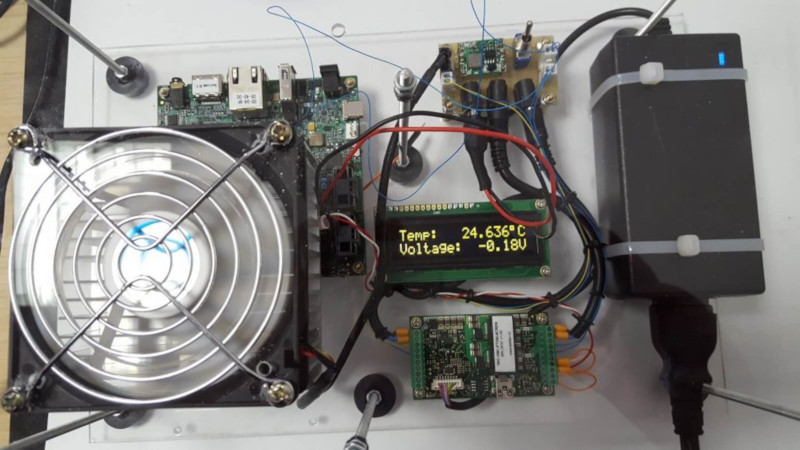Testing is a key part of any product development cycle. Done right, it turns up unknown bugs and problems, and allows for them to be fixed prior to shipment. However, it can be a costly and time-consuming process. The [Bay Libre] team needed to do some work on power management, but the hardware required was just a little on the expensive side. What else does a hacker do, but build their own?
Enter the Thermo-Regulated Power Measurement Platform. It’s a device designed to control the die temperature of a chip during process characterization. This is where a chip, in this case the iMX8MQ, is run at a variety of temperatures, voltages, and frequencies to determine its performance under various conditions. This data guides the parameters used to run the chip in actual use, to best manage its power consumption and thermal performance.
The rig consists of a Peltier element with controller, a heatsink, and a fan. This is lashed up to a series of Python scripts that both control the chip temperature and run through the various testing regimes. Thanks to this automation, what would normally be a day’s work for an engineer can now be completed in just two hours.
Through a few smart component choices, the team accomplished the job at around one-tenth of the cost of commercial grade hardware. Granted, the average hacker probably won’t find themselves doing process characterization for cutting-edge silicon on a regular basis. Still, this project shows the value in building custom hardware to ease the testing process.
Testing is key to success in production. Custom jigs can make for light work when large orders come in, and we’ve run a primer on various testing techniques, too.
















Measuring down to one 1/1000 of a degree. That doesn’t sound like “cheap” to me.
*displaying* to 1/1000 of a degree is cheap, though.
Even *measuring* to 1/1000 of a degree (~110 dB SNR or dynamic range) isn’t insurmountable if you don’t have to do it too quickly.
Getting a real precision (i.e., reproducibility) of +/- 0.001 degree is hard.
Getting a real accuracy (i.e., traceable to a standard) of +/- 0.001 degree is essentially impossible.
That’s what I was implying :) Irony doesn’t always survive the trip through the intertubes hehe.
What a nice LCD display! Too bad they did not publish its part number…
It’s a http://www.newhavendisplay.com/specs/NHD-0216KZW-AY5.pdf
Nearly obsolete, and not cheap.
In my experience they also age poorly: they burn in characters if left on too long (as in, a few dozen hours).
Many thanks! I thought it was some fancy type of LCD as stated in the article. OLEDs are nice, but they really suffer from burn out.
Looks like a Hitachi HD44780 derivative LCD… If you want to consider something functionally similar you might want to look at the Noritake VFDs. They are available in similar forms, both graphical and character (the character ones are even HD44780 drop in replacements) and are EXCELLENT for readability, etc. I like to use these professionally (though they are a bit more spendy than LCDs), and personally (can very frequently scavenge these from older electronics!).
With edge of space ballooning becoming more popular this could well be a good project in itself for the run up to a launch. Maybe with a little stabilization ballooning to the edge and rocketing a little further could even be within reach of college students and back yard experimenters alike.